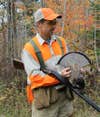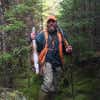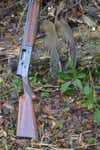Great Field Guns and the Hunters Who Use Them
Why would anyone hunt with a museum-quality firearm? Because life’s too short to hunt with an ugly gun

We may earn revenue from the products available on this page and participate in affiliate programs. Learn more ›
There are collectors and there are hunters, and while I can appreciate the fine guns that are displayed in places such as the Cody Firearms Museum, I prefer to take my long-guns afield simply because quality firearms can make even game-less days more enjoyable. They look great, carry impeccably and all you have to do is to wipe them down when you’re done, send them to the gunsmith for a periodic cleaning, and you’re all set to utilize them in the manner for which they were created. If you’re a fan of high-quality firearms and aren’t afraid of getting them wet, muddy, or covered with snow, you’re not alone. The following guns aren’t necessarily all high-value collector’s items—unless you’re one of the hunters who gets to tote them around. And these hunters and shooters do just that—all for rather unique reasons.

1. Burt’s Gun
Friendsville, Pennsylvania—Field & Stream readers remember Burton L. Spiller as the Poet Laureate of grouse hunting. His first byline, “His Majesty, the Grouse” appeared in 1932, and the rest is history. Spiller contributed more than 50 pieces over the next four decades, and wrote several books on the subject as well. His Parker VH 20, which was built in 1934, was as legendary as the sword Excalibur, and became immortalized in outdoor lore.
Spiller hunted with many F&S writers and editors, and one of his buddies was “Tap’s Tips” author, Tap Tapply. When Tapply’s son Bill came of age he joined the crew, and that’s when the magic happened. Spiller casually asked the young Tapply if they could swap shotguns—his Parker for young Tapply’s single-shot Savage 20 gauge. The boy agreed, and that’s how the 78-year old legend bequeathed his favorite shotgun. Many years later Bill Tapply wrote about that event in the November 1982 issue of guess which magazine: Field & Stream. The masterpiece is titled “Burt’s Gun.”
“Burt’s Gun” is currently owned by Morris Baker, the owner of RST Shotshells, a man who truly recognizes the shotgun’s provenance. I had the opportunity to see that Holy Grail several years ago while having a cup of coffee with Baker in his Pennsylvania ammunition factory.
“Wanna shoot it?” he asked.
“Heck yeah,” I said, and off we went up the road to his friend’s clays course called Hausmann’s Hidden Hollow.
Based on the stock dimensions I shouldn’t have hit a single clay. It was too short for me, and there was far too much drop at comb and at heel. But there was magic in that shotgun, and a 3/4 ounce RST 20-gauge load from its cylinder bore crushed orange disc after disc. That shotgun has good juju, and it’s wonderful that Morris shoots it instead of storing it in a museum.

2. The Shooting Sportsman
Camden, Maine—When Ralph Stuart was a senior editor at Outdoor Life, he carried a 12-bore Ithaca Model 37 for everything with feathers or fur. Stuart used it on upland birds, waterfowl, turkeys, and rabbits. That Ithaca was his go-to shotgun. A few decades ago a career change landed him in the editor’s chair at Shooting Sportsman magazine. Ever since then he’s been surrounded by some of the finest shotguns in the world—and if he can see the light, anyone can.
“I think we’re starting to see an increase in the number of fine shotguns used on the water and in the woods,” says Stuart. “There are fewer collectors these days, and with that comes an increase in high-quality firearms in the marketplace. The next generation of hunters will be their owners—and they will carry these fine firearms into the pheasant and quail fields, in the grouse covers, and on sea duck hunts along the coast. By no stretch of the imagination am I a new hunter, but I am somewhat of an example of that trend. I now shoot and hunt with a wonderful Francotte 16 bore with 28-inch barrels, a single trigger, and removable side locks. And I must say, a fine shotgun adds immeasurably to the enjoyment of our sport.”

3. The Captain’s Grouse Gun
Fredrick, Maryland—In 1968, Captain Bob Priest, USMC retired, saw a Marine exit the Khe Sahn jungle with perfectly-polished boots.
“That is the definition of elegance,” says Priest. “Elegance doesn’t mean expensive. It means being able to discern quality—whether it be in a bird dog or a grouse cover. A tailgate lunch that raises the bar above PB&J’s can be elegant. White linens as table clothes with crystal stemware isn’t relevant; the best quality used to its fullest capacity is the key. Hunting buddies think I’m crazy to carry my Westley Richards drop lock over stone walls, through river lowlands, and across barbed-wire fences that characterize the grouse woods. The scratches in the receiver’s case colors and the dings in the stock are emblems of my life spent in the woods doing what I love to do. And I remember how every imperfection came to be with fondness, for they are the hallmarks of a life well lived. Be the best you can be and use the best you can afford. We only go around once in life but if we do it right once is enough.”

4. Lars’ Legend
Dorset, Vermont—For his Legend’s Program, Lars Jacob of Lars Jacob Wingshooting sources high-quality, affordable firearms from the UK. Their provenance is discernable because Continental proof houses add a measure of authenticity to each firearm.
“The American mentality is predisposed to buying new firearms rather than antiques,” says Jacob. “But across the pond, proof houses record all metal work done to a firearm. If you see a “C” marked on either the frame or on the barrel lugs, then you know that a chamber was lengthened or re-sleeved. Similarly, a “B” marked on the frame represents that the barrel was re-sleeved. These proof houses add a traceable history of performed repairs and consumer confidence comes with that recognizable legitimacy. American gunsmiths don’t record modifications, and that’s likely why stateside hunters and shooters choose modern firearms instead of classics.
“My current upland favorite is a between-the-wars Webley & Scott, a 16-bore with 30-inch tubes. Most shooters reading a description of a larger-bore with long barrels would pass on the gun thinking it was heavy and useful only on driven shoots or for waterfowl. But that is the furthest from the truth. On a side-by you’ll find only a small sliver of walnut called a splinter fore-end. Designers used the splinter fore-end for the purpose of hiding the cocking mechanisms and not as a grip. The result is barrels that sit in close contact with the shooter’s lead hand. Such increased contact results in greater and enhanced pointability if properly used. There is less metal and wood, so the guns are light. That Webley & Scott weighs a scant 5 pounds, 7 ounces and offers the stability found in 30-inch barrels and a response common with 26-inch tubes. And it didn’t cost a fortune.”

5. Raley’s Classics
Columbia, South Carolina—Brian Raley’s firearm collection changes from time-to-time, but his two guiding principals remain: Raley favors classic firearms and he’s not afraid to use them.
“Throughout the year I hunt for a lot of different species,” Raley says. “Sometimes I travel to Michigan to hunt whitetails while other times I’ll shoot hogs not far from home. Look for me at a September dove shoot or walking behind my Britney for pre-Christmas quail—I may buy and sell guns all the time, but I always shoot
“For big game I’ll shoot my pre-1964 Model 70 in .30-06. The machining is excellent, the walnut superb, and I like the controlled-round feeding that comes from the Mauser-style action. That rifle is reliable and it feels perfect in my hands. There is a reason that the Model 70 has been called “The Rifleman’s Rifle” for nearly a century.
When it comes to a shotgun, I instinctively reach for my Ithaca Flues 20 gauge. The 26-inch barrels balance perfectly in my hand and I like the double triggers for barrel selection. The fixed chokes are Improved Cylinder/Modified, and I can change effective distances by loading different shells. For doves, I’ll use a standard 7/8-ounce load and for wild quail I’ll use a 3/4 ounce in the right barrel and a 7/8 ounce for the left. The spread is more open on the first shot and reaches out a bit further on the second shot.
“I like both of those firearms for two reasons. First, it’s always a pleasure to hold a well-crafted firearm with a high-quality walnut stock, well-constructed design, and precise fit and finish. But the second is tradition. Older firearms connect me to their previous owners and to the times they spent hunting game with family and friends. That’s a tough connection to beat which is why my son and now my grandson are going to inherit my entire firearm collection.” **

6. The Beagle Bard’s Battery
State College, Pennsylvania—Pastor Bob Ford, aka the Beagle Bard, is a sermonizing, rabbit hunter from central Pennsylvania. When Ford isn’t in the pulpit or at a field trial he’s swinging one of his American classics or a German Merkel or a Spanish Ugartechea at rabbits.
“One of my favorite shotguns is my first nice rabbit gun which is a 16-gauge Fox Sterlingworth,” says Ford. “I bought it for a song because there was a crack in the pistol grip. I hunt every day except for Sunday, and by the end of the season that crack got worse. The gunsmith couldn’t fix it, so I needed a new stock. Being on a pastor’s salary I didn’t have a few thousand dollars for a stock, so I bought another Sterlingworth in 16 gauge. And a few years ago a miracle happened. My nephew retired from the United States Army as a Lt. Colonel and was looking for a part-time job. He went to gunsmith school, and wouldn’t you know that one of his school projects was to build a stock for an old firearm? He built me a new stock for the Sterlingworth so now I have two. And this one’s stock isn’t really new anymore. I’ve added a few scratches and dings during our four-month hunting season.”

7. The Brooks Range
Colorado Springs, Colorado—Come fall, Paul Brooks, the manager of Bass Pro Shops’ White River Fly Shop, trades in his fly rods for rifles and shotguns.
“My gun safe offers more than a few choices for the big game and bird hunting that I do,” says Brooks. “But over the years I seem to choose my Winchester Model 21 Field Grade for bird hunting and my single shot, falling block Ruger #1. It’s chambered in .300 Weatherby Magnum with a Swarovski Habicht scope. I spend a lot of time in rugged terrain, whether it’s above 7000-foot elevation for elk or above the tree line for ptarmigan. Because of the conditions I need quality firearms that are up for the task.
Read Next: The 10 Best Deer Camp Rifles

“The history of these older guns on a hunt gives them soul, and with each hunt I contribute my own personal history. I fell trees with an axe used by my father just as I smoke a pipe packed and lit by my grandfather. I swing that axe in all kinds of weather just as I light the pipe when I want a smoke. Hunting with a fine firearm only in perfect conditions is not something that would occur to me. Those firearms, vintage or not, were made to be used on a hunt—in fair weather or in bad, in smooth terrain or in rough. They were made to be used in the woods and in the fields and that’s precisely what I do.”

8. New York Customs
Windham, New York—Brian Casamento has owned a lot of firearms, but his very favorite rifles and shotguns are ones he made himself.
“When I was working as the head of Marine Patrol for the New York Sheriff’s Office, I met a man named Bill Playford,” says Casamento. “Bill had a gunsmith’s shop in the Catskills, and I spent a lot of time with him. He was impressed with my knowledge of firearms, but it came to me naturally. My stepfather, you see, was a machinist for Colt Firearms in Hartford, and he taught me a lot about the process of making firearms. A go-to favorite of mine is an original .270 Ruger M77 that is now a .35 Whelen. I shot it so much that I wore out the barrel. Instead of buying a new gun, I bought a lapped-trued Wilson .358 caliber barrel which I chambered to .35 Whelen. Then I built a custom stock. After that I overhauled the barrel bedding and hand lapped the bolt lugs so that the firearm was perfectly squared and properly fit. I finished off the barrel with a muzzle break and then hand-filed a custom trigger guard made from an old, blocky military-version. I can control what I make, but I can’t control the weather, and that’s why my custom rifles accompany me on every hunt. There is a lot of joy in taking game with a rifle I’ve made, even when they come back a little worse for the wear. I don’t shy away from using them one bit. It’s what they were made for, isn’t it?”

9. Perfect Pair For Squirrels
Deltona, Florida—Jim Turlington, a well-known sporting artist in Central Florida, hunts squirrels with a .410 J.C. Higgins Model 1011, single-shot hammer gun and a 12 gauge Belgian Browning A-5.
“My dad is involved with both shotguns,” says Turlington. “He bought me the .410 from Sears, Roebuck and Company when I was old enough to start hunting. It’s a late 1940s shotgun that was made by Savage Arms, and because of its age most people believe it’s an heirloom and that I should leave it at home. But I shot my first quail, wood duck, and rabbit with that shotgun, so it’s got a lot of fond memories from my childhood. The full choke means I can reach out and touch squirrels that are high in the trees.
“The A-5 was my dad’s gun which was made in 1952. He bought it brand new when he was stationed at Fort Leonard Wood in Missouri. I’ll never forget when he passed it down to me, and nothing feels better than stalking around the creek bottoms and swamps looking for squirrels and wood ducks. Sure it gets wet and muddy, but I just give it a thorough cleaning. No new gun could possibly make me think of the fun times I’ve had learning to hunt or of hunting with my dad.”
Read Next: Best Cheap Guns: 26 New Firearms That Won’t Blow Up Your Bank Account

10. Hammer Time
Asheville, North Carolina—Don Mallicoat isn’t opposed to hanging fine firearms on a wall, but sooner or later he takes them down and puts them to use.
“When I owned my gun shop I bought a nice little shotgun from an older gentleman,” says Mallicoat. “It was a Belgian trade gun made in Liege for the Russell Arms Company. The side-by-side shotgun was old enough to have two external hammers, and the twist barrels were made from Damascus steel. But the action was tight, the hammers were intact, and the bores and barrels were perfect. It was such an interesting piece that I purchased the shotgun and hung it on the shop wall for several years. But one I day I took it down. I hand loaded a box of low-compression shells, and with that I headed off to the skeet range. It shoots like a dream, so this year I’ll take it into the woods and fields for grouse, woodcock, and dove.”

11. Doc Rock
Castle Rock, Colorado—Is there a chance that if you take your 1968 Camaro ragtop out for a ride that you’ll get into a fender bender? Absolutely, but that’s no reason not to take it for a spin. Last September, Shawn Wayment, Colorado’s ‘Bird Dog Doc’ veterinarian took a digger hunting white-tailed ptarmigan above the Colorado tree line.

Says Wayment, “I humped for three hours to access a birdy spot at 13,000 feet. There isn’t much vegetation above the tree-line, just boulder fields, rocks, and loose shale. Flushed birds head to the rocks, and one that I shot tucked in to a tight crevice that my setter couldn’t reach. I went in for the retrieve and slipped and fell. The impact of my fall dented the end of the right barrel on my mid-1920s Ithaca NID Grade 1 .410. There were some gouges to the stock, but the left barrel and frame were fine. Six hours of round-trip hiking is a big effort for a hunt, but I didn’t want to just walk down the mountain. Since the left tube was safe to shoot I filled my limit by shooting birds over points on the way down. The cost to fix the barrel and stock was $1600 but I didn’t pay a dime. All of my firearms are insured by the USAA insurance policy I carried over from my time spent in the U.S. Army’s 82nd Airborne. Most hard-core hunters will have an accident at some point, and since firearms can be repaired I see no reason to leave a favorite in the gun safe at home.”
